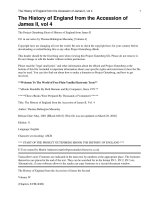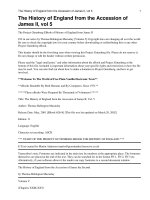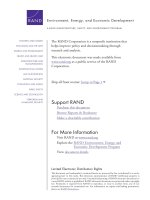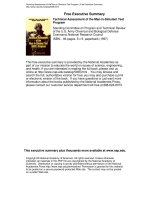The Reliability of Scores from the 1992 Vermont Portfolio Assessment Program potx
Bạn đang xem bản rút gọn của tài liệu. Xem và tải ngay bản đầy đủ của tài liệu tại đây (835.27 KB, 72 trang )
For More Information
Visit RAND at www.rand.org
Explore the RAND National Defense Research Institute
View document details
Support RAND
Purchase this document
Browse Reports & Bookstore
Make a charitable contribution
Limited Electronic Distribution Rights
is document and trademark(s) contained herein are protected by law as indicated in a notice
appearing later in this work. is electronic representation of RAND intellectual property is
provided for non-commercial use only. Unauthorized posting of RAND electronic documents to
a non-RAND website is prohibited. RAND electronic documents are protected under copyright
law. Permission is required from RAND to reproduce, or reuse in another form, any of our
research documents for commercial use. For information on reprint and linking permissions,
please see RAND Permissions.
Skip all front matter: Jump to Page 16
e RAND Corporation is a nonprot institution that
helps improve policy and decisionmaking through
research and analysis.
is electronic document was made available from
www.rand.org as a public service of the RAND
Corporation.
CHILDREN AND FAMILIES
EDUCATION AND THE ARTS
ENERGY AND ENVIRONMENT
HEALTH AND HEALTH CARE
INFRASTRUCTURE AND
TRANSPORTATION
INTERNATIONAL AFFAIRS
LAW AND BUSINESS
NATIONAL SECURITY
POPULATION AND AGING
PUBLIC SAFETY
SCIENCE AND TECHNOLOGY
TERRORISM AND
HOMELAND SECURITY
is report is part of the RAND Corporation research report series.
RAND reports present research ndings and objective analysis that ad-
dress the challenges facing the public and private sectors. All RAND
reports undergo rigorous peer review to ensure high standards for re-
search quality and objectivity.
Critical
Materials
Present Danger to U.S. Manufacturing
RICHARD SILBERGLITT, JAMES T. BARTIS,
BRIAN G. CHOW, DAVID L. AN, KYLE BRADY
C O R P O R AT I O N
NATIONAL DEFENSE RESEARCH INSTITUTE
Prepared for the National Intelligence Council
Approved for public release; distribution unlimited
Critical
Materials
Present Danger to U.S. Manufacturing
RichaRd SilbeRglitt, JameS t. baRtiS,
bRian g. chow, david l. an, Kyle bRady
The RAND Corporation is a nonprofit institution that helps improve
policy and decisionmaking through research and analysis. RAND’s
publications do not necessarily reflect the opinions of its research clients
and sponsors.
R
®
is a registered trademark.
© Copyright 2013 RAND Corporation
Permission is given to duplicate this document for personal use only, as
long as it is unaltered and complete. Copies may not be duplicated for
commercial purposes. Unauthorized posting of RAND documents to
a non-RAND website is prohibited. RAND documents are protected
under copyright law. For information on reprint and linking permissions,
please visit the RAND permissions page ( />publications/permissions.html).
Published 2013 by the RAND Corporation
1776 Main Street, P.O. Box 2138, Santa Monica, CA 90407-2138
1200 South Hayes Street, Arlington, VA 22202-5050
4570 Fifth Avenue, Suite 600, Pittsburgh, PA 15213-2665
RAND URL: />To order RAND documents or to obtain additional information, contact
Distribution Services: Telephone: (310) 451-7002;
Fax: (310) 451-6915; Email:
Library of Congress Cataloging-in-Publication Data is available for this publication.
ISBN: 978-0-8330-7883-4
The research described in this report was prepared for the National
Intelligence Council. The research was conducted within the RAND
National Defense Research Institute, a federally funded research and
development center sponsored by the Office of the Secretary of Defense,
the Joint Staff, the Unified Combatant Commands, the Navy, the Marine
Corps, the defense agencies, and the defense Intelligence Community under
Contract W74V8H-06-C-0002.
iii
Preface
is report describes the results of a study of the sources and reliability of the supply
of imported materials on which United States manufacturers are dependent. It should
be of interest to a broad spectrum of individuals and organizations in the materials and
manufacturing sectors as well as government, private sector, and non-prot organiza-
tions involved with or concerned about those sectors.
is research was sponsored by the National Intelligence Council and conducted
within the Intelligence Policy Center of the RAND National Defense Research Insti-
tute, a federally funded research and development center sponsored by the Oce of the
Secretary of Defense, the Joint Sta, the Unied Combatant Commands, the Navy,
the Marine Corps, the defense agencies, and the defense Intelligence Community.
For more information on the RAND Intelligence Policy Center, see http://www.
rand.org/nsrd/ndri/centers/intel.html or contact the director (contact information is
provided on the web page).
v
Contents
Preface iii
Figures
vii
Tables
ix
Summary
xi
Acknowledgments
xvii
Abbreviations
xix
CHAPTER ONE
Introduction 1
Recent Analyses of Critical Raw Materials
2
Our Approach
4
CHAPTER TWO
Concentration of Production of Critical Raw Materials 5
CHAPTER THREE
China’s Role as a Controlling Producer 11
China’s Policies Cause Concern Among Its Customers
11
China’s Customers Pursue Relief at the World Trade Organization
15
CHAPTER FOUR
Tungsten: Case Example of a Critical Raw Material 17
Uses and Importance of Tungsten
17
Tungsten Resources and Reserves
18
e Tungsten Supply Situation
18
Potential Impacts of the Tungsten Supply Situation
28
CHAPTER FIVE
Conclusions and Response Options 31
Increasing Resiliency to Supply Disruptions or Market Distortions
32
Diversifying Production
33
vi Critical Materials: Present Danger to U.S. Manufacturing
Long-Term Actions to Increase Resiliency 33
Foresight of Developing Problems
33
APPENDIXES
A. Top ree Producers of the 41 EC Critical Raw Materials 35
B. e World’s Largest Tungsten Deposits
41
Bibliography
43
vii
Figures
S.1. Percentage of Global Production (Mining) of Key Materials Within a Single
Country
xii
S.2. Concurrent Rise in China’s Market Share of Key Materials and the Number of
Export Restrictions Applying to em
xiii
2.1. HHI Index for the 41 EC Critical Raw Materials
6
2.2. HHI (Minus U.S. Production) Adjusted for Foreign Supplier Governance
7
3.1. Growth of China’s Global Raw Material Production
12
3.2. Chinese Export Restrictions and Market Share
13
4.1. World Tungsten Deposits
19
4.2. World Tungsten Reserves
20
4.3. Projected Years of Tungsten Supply Based on Production
20
4.4. Projected Years of Tungsten Supply Based on Consumption
21
4.5. World Tungsten Production
21
4.6. Schematic Representation of the Tungsten Supply Chain
23
4.7. Tungsten Raw Materials Supply Network
24
4.8. Chinese Domestic Consumption and Exports of Tungsten
25
4.9. Tungsten Price Increases in 2010 and 2011
26
4.10. U.S. Tungsten Production and Dependence on Imports
27
ix
Tables
2.1. Key Indicators of the Security of Supply for Important Raw Materials 9
3.1. Chinese Two-Tier Pricing of Rare Earth Materials
14
A.1. Top ree Producers of the 41 EC Critical Raw Materials
35
B.1. e World’s Largest Tungsten Deposits
41
xi
Summary
Critical Materials: The Problem
e U.S. economy, and especially its manufacturing sector, is dependent on the supply
of raw and semi-nished materials used to make products. While the United States has
extensive mineral resources and is a leading global materials producer, a high percent-
age of many materials critical to U.S. manufacturing are imported, sometimes from a
country that has the dominant share of a material’s global production and export. In
this situation, U.S. manufacturers are vulnerable to export restrictions that limit their
access to these materials and that can result in two-tier pricing, under which domestic
manufacturers in the producing country have access to materials at lower prices than
those charged for exports, thereby hindering the international competitiveness of U.S.
manufacturers and creating pressure to move manufacturing away from the U.S. and
into the producing country.
Several reports over the past four years have analyzed the economic importance
and supply risks of a large number of materials from various perspectives, with substan-
tial overlap and agreement. Starting from this base, we focus our analysis on a subset of
materials for which production is concentrated in one or a few countries and for which
the following conditions apply:
• e dominant producer is outside the United States.
• e United States has appreciable net imports.
• e dominant producers have shortfalls in their quality of governance, as mea-
sured by the Worldwide Governance Indicators (WGI) published by the World
Bank.
We nd that one country, China, is in a unique position in that it is the only
country that satises the above conditions and produces more than 50 percent of the
global production of more than one material critical to U.S. manufacturing. In fact,
China produces more than 50 percent of 11 of these materials, nine of which were
xii Critical Materials: Present Danger to U.S. Manufacturing
identied in one or more of the previous reports as having high economic importance
and high supply risk (see Figure S.1).
ree of these materials (rare earths [REs], antimony, and tungsten) are dicult
to substitute without signicantly increasing the cost or decreasing the performance of
the products they are used to make. REs are used in lasers and many components of
electronic devices and defense systems, antimony is critical to ame retardant plastics
and textiles, and tungsten is used to produce cemented carbides for cutting tools used
in many industries. Moreover, the United States is heavily dependent on imports for
all three of these materials; virtually 100 percent of REs and 90 percent of antimony
are imported.
Trends in China’s Role
China’s market share of the global production of critical materials has grown dramati-
cally over the past two decades from a strong position to an overwhelmingly domi-
nant one. For example, China’s share of tungsten and antimony production, already
60 percent in 1990, is now over 80 percent for tungsten and about 90 percent for
antimony. As China’s market share and domestic consumption have grown, its mate-
Figure S.1
Percentage of Global Production (Mining) of Key Materials Within a Single Country
SOURCE: U.S. Geological Survey, Minerals Commodity Summaries, Pittsburgh, Penn.: U.S. Government
Printing Office, 2012; International Organizing Committee for the World Mining Congresses, World
Mining Data, Vol. 26, 2011.
RAND RR133-S.1
Antimony (Sb)
China
Germanium
China
Niobium
Brazil
Barites
China
Graphite
China
Platinum Group
South Africa
Cobalt
Congo
Indium
China
Rare earths
China
Fluorspar
China
Magnesite
China
Rhenium
Chile
Gallium
China
Magnesium
China
Tungsten
China
90%
51% 53% 55% 60%
68% 65% 56%
70%
86%
92%
59%
97%
53%
86%
Summary xiii
rials export policies have moved in a direction that has created concern among its
customers. In particular, China has instituted a combination of production controls,
export restrictions (e.g., quotas and taris; see Figure S.2), mine closings, and company
consolidation.
e increases in export restrictions illustrated in Figure S.2 initially focused
almost solely on REs and tungsten, but in 2007 and 2008 broadened to include other
materials. e combined eect of export restrictions and worldwide demand for these
materials has contributed to signicant increases in their price and, in some cases, vola-
tility on the world market. For example, the price of rare earth metals doubled from
2010 to 2011, while prices of some elements, such as lanthanum and cerium (both
REs), reportedly rose as much as 900 percent. Prices of antimony and tungsten more
than doubled over this same period.
e export restrictions have resulted in a two-tier pricing system for certain mate-
rials of which China is the dominant producer, including its rare earth metals, allow-
ing China’s domestic manufacturers to pay a lower price than the export price. By
undercutting the market price, China’s actions have both discouraged the continua-
tion of manufacturing in the United States and provided motivation for moving U.S.
manufacturing operations specically to China.
Figure S.2
Concurrent Rise in China’s Market Share of Key Materials and the Number of Export
Restrictions Applying to Them
SOURCES: U.S. Geological Survey, Minerals Commodity Summaries, 2003–2010; Jane Korinek and
Jeonghoi Kim, “Export Restrictions on Strategic Raw Materials and Their Impact on Trade and the Global
Supply,” OECD Trade Policy Papers, No. 95, Paris: OECD Publishing, 2010; Strategic Metal Investments,
Ltd., China’s Growing Role in the Production and Supply of Minor Metals: Part II, May 10, 2010.
RAND RR133-S.2
Percentage of market share
Number of export restrictions
60
58
56
54
52
50
20072006200520042003200220012000 2008
48
46
44
Year
62
10
8
6
4
2
0
12
Average market share of
materials listed in Table 2.1
New export restrictions
implemented
xiv Critical Materials: Present Danger to U.S. Manufacturing
Attempts to Counter China’s Actions
In response to these actions, two separate complaints were brought against China at
the World Trade Organization (WTO) over the past three years. In 2009, the United
States, followed by the European Union (EU), and later Mexico, brought a complaint
against China’s trade restrictions on various forms of bauxite, coke, uorspar, mag-
nesium, manganese, silicon carbide, silicon metal, yellow phosphorus, and zinc. e
WTO ruled in 2011 that China’s export duties and export quotas on these materials
were in violation of WTO rules. is ruling was upheld after appeal in January 2012
and, at the time of this writing, China’s compliance actions were not yet dened. In
March 2012, the United States, EU, and Japan brought a new WTO complaint against
China’s trade restrictions on REs, tungsten, and molybdenum. At the heart of both
of these complaints, as stated by U.S. and European trade representatives, are China’s
export restrictions, leading to the two-tier pricing structure and its eect on the com-
petitiveness of U.S. and European rms.
As evidenced by the dates given in the previous paragraph, actions at the WTO
can take several years. Opening new mines outside China, including the necessary
permitting and compliance with regulations and standards, can also take several years
and can require hundreds of millions, or even billions, of dollars in a market that is
uncertain because of the market power held by a dominant producer. Yet the impacts
on manufacturers dependent on imported materials occur much more rapidly. A 2011
global survey of manufacturers
1
found that a majority believe that supply risks will
rise signicantly over the next decade and that the impact will be felt throughout the
supply chain. In some industries (renewable energy, automotive, and energy and utili-
ties), responses suggested that supply instability is currently being experienced.
A Case Study: Tungsten
As an example, we studied the supply situation for tungsten, a critical raw material
and one for which U.S. manufacturers depend on imports. China is the controlling
producer of tungsten, with more than 80 percent of 2010 world production and esti-
mated 2011 world production. e leading use of tungsten today is for cemented car-
bides, composite materials that are used worldwide for drilling, cutting, and machin-
ing. ese materials are critical to every industrial application that involves cutting or
component wear—mining; construction; oil and gas exploration; tools and dies; and
the cutting of wood, plastics, and metals. Tungsten is thus a basic commodity under-
pinning the global manufacturing sector.
1
Price Waterhouse Coopers, Minerals and Metals Scarcity in Manufacturing: e Ticking Timebomb: Sustainable
Materials Management, December 2011.
Summary xv
We found that China is the dominant exporter of both raw tungsten and the
intermediate tungsten products that are essential inputs to manufacturing. As a result
of China’s export policies and growing domestic demand for tungsten, analysts both
inside and outside of China project a tight supply situation to continue for the next
several years. e lack of access to tungsten materials by manufacturers outside of
China presents a threat to the manufacturing sector elsewhere in the world and cre-
ates pressure on manufacturers to move operations to China. U.S. manufacturers have
responded to this threat by increasing secondary production from waste and scrap,
reducing their dependence on imports by about one-third. ey are also taking steps
to reduce the amount of tungsten used in products and to nd alternative materials.
However, it is not clear how much more secondary production can be increased, and
reduction and substitution measures that do not aect product performance require
concerted eort. In the meantime, dicult access to supply increases pressure to move
manufacturing from the United States to China. Moreover, prolonged disruption in
the supply chain for tungsten and other critical raw materials could jeopardize the U.S.
science and technology base for these materials and, consequently, U.S. innovation and
competitiveness in new products manufactured from them.
Conclusion: Concentration of Supply and Effective Response
We conclude from the data and analyses described in the text of this report that the
critical issues associated with the supply of minerals are less about the minerals them-
selves than they are about where the raw and semi-nished materials that are derived
from these minerals and that underpin economies are produced and processed. One
clear conclusion is that countries commanding a large market share of a material’s
production can distort mineral commodity markets through production controls and
export restrictions. us it is the concentration of supply, in particular the concentra-
tion among producing countries that either have weak governance or that control pro-
duction at the governmental level, or both, that can increase the potential for supply
disruptions.
China is the dominant producer and exporter of many critical materials. Its stra-
tegic material policies include (1) trying to gain control of production outside of China
(i.e., by obtaining controlling interests in mines outside of China that produce materi-
als such as antimony and REs, of which it is already an overwhelmingly controlling
producer) and (2) establishing production quotas and export restrictions. ese policies
have contributed to large price increases, some price volatility, and tight markets, as
well as uncertainty that can hinder the nancing of new mining projects. Moreover,
China’s policies contrast with those of other countries with high market shares, such
as Chile (with 53 percent of rhenium) and Australia (with 51 percent of zirconium),
xvi Critical Materials: Present Danger to U.S. Manufacturing
which do not implement export restrictions, instead allowing market forces to largely
determine the supply and demand of the minerals they produce.
e impact of these policies on the global manufacturing sector suggests the need
for two types of actions: (1) those that can increase resiliency to supply disruptions or
market distortions and (2) those that can provide early warning of developing prob-
lems resulting from the concentration of production. Actions to increase resiliency
should be aimed at the diversication of production and processing, as well as the
development of new methods of extraction, processing, and manufacturing that will
improve the eciency of material use and increase the recovery of materials from waste
and scrap. Actions to provide early warning could be based on benchmarking market
activity with diversied commodity markets and international coordination and coop-
eration that could potentially prevent the situation from reaching the level requir-
ing action at the WTO. e goal of such coordination and cooperation should be to
smooth market distortions while allowing for the natural economic development of
producing countries.
xvii
Acknowledgments
We gratefully acknowledge helpful discussions and interactions with many colleagues,
including Steven Berner, Cortez Cooper, John Fei, Eric Landree, Victoria Greeneld,
John Parachini, Andrew Scobell, Howard Shatz, Jerey Stricker, Lloyd rall, and
Kathi Webb of RAND, as well as sta of the U.S. Departments of Energy and Home-
land Security, the U.S. Environmental Protection Agency, the U.S. Geological Survey,
and the U.S. Trade Representative. We also proted from discussions with several
individuals in the private sector who are directly involved with materials and manu-
facturing, as well as discussions with sta of the National Mining Association and the
International Tungsten Industry Association. We thank all of these individuals for pro-
viding information and perspectives that contributed greatly to our research.
We are especially grateful to the peer reviewers of this report, Andrew Scobell
and Howard Shatz of RAND, and Professor Rod Eggert of the Colorado School of
Mines. eir insightful comments and suggestions led to substantial improvements in
the quality of the manuscript.
xix
Abbreviations
APT ammonium paratungstate
DOE Department of Energy
EC European Commission
EU European Union
FOB Free on Board
HHI Herndahl-Hirschman Index
IDA Institute for Defense Analysis
ITIA International Tungsten Industry Association
mtu metric ton unit
NDS National Defense Stockpile
NRC National Research Council
PGM Platinum group metals
RE rare earth element
REACT Rare Earth Alternatives in Critical Technologies
SMSP Strategic Materials Security Program
USGS U.S. Geological Survey
VAT value-added tax
WGI Worldwide Governance Indicators
WTO World Trade Organization









